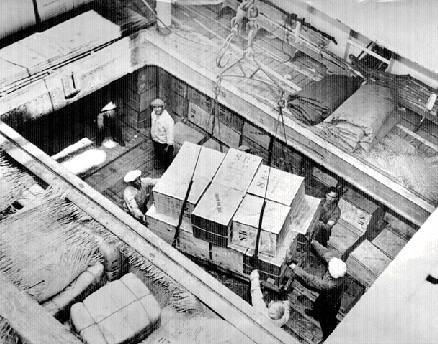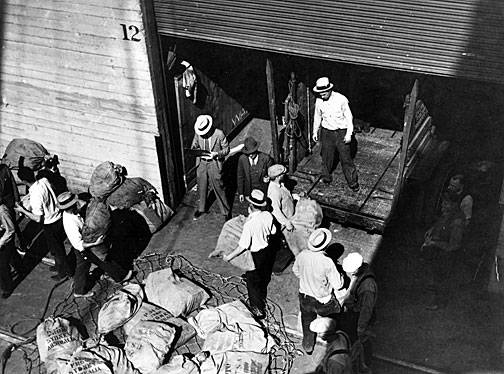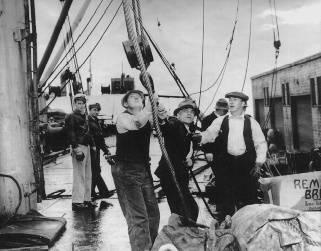The Dialogue
Historical Essay
by Herb Mills,
from The San Francisco Waterfront: The Social Consequences of Industrial Modernization, Part One: The Good Old Days
Longshoreman working in a ship's hold.
Photo: San Francisco History Center, SF Public Library
A centralized sign-in and dispatch for work and the physical existence of a hiring hall meant that over a period of time the hall men became very well acquainted. Their acquaintance was also reinforced when they were dispatched to the same gang, ship or dock. Since hall men were dispatched to fill out the gangs with needed men, acquaintances between the hall and gang men also developed over time. The men of different gangs were likewise destined to become acquainted by being dispatched to the same ship and, not infrequently, by having been assigned to opposite ends of the same hatch. With the passage of time, then, most of the San Francisco longshoremen had developed at least some acquaintanceship with all of their union brothers. The average longshoreman was also destined to become very well acquainted with a considerable number of those men. For most men, such acquaintanceships frequently grew into a real and lasting friendship. Friendships were also spawned and strengthened over breakfast at the many waterfront cafes, at the coffee break, with a deck of cards at lunch, and when the men were sent to supper prior to finishing a vessel (this continued until 1966). Then, too, some of the brothers were not adverse to getting together for a drink or two following the end of their shift.
<iframe src="http://archive.org/embed/HerbMillsTheOldDays" width="640" height="480" frameborder="0" webkitallowfullscreen="true" mozallowfullscreen="true" allowfullscreen></iframe>
Herb Mills shares his thoughts on the "old days" on the waterfront, both in terms of the work and the workers, and the scene along the old City Front.
Video: Chris Carlsson
Endless conversation thus ensued. As might be supposed, such conversation frequently drifted to the work and to union matters. But the men were also known to discuss such diverse topics as women, baseball, gambling and horse racing, capitalistic exploitation and the profit motive, fascism, and, of course, the great depression -- that unforgettable fountain of experience from which they had all been obliged to drink. There emerged a quite extraordinary world of discussion, reflection and debate.
On the job, with lots of chance for conversation while working, c. 1940s
Photo: ILWU Archive
The opportunity for conversation did in no way end when the men went to work at the beginning of their shift or when they returned from lunch or supper. There was little machine noise (and no sustained machine noise) either on the dock or in the cargo sheds. This was also true aboard ship, except when older Johnson-bar steam winches were being used, but even then the cycle of the cargo hook meant that the clattering of the hoisting gear was at least intermittent. Then, too, the pace and cycle of the work between the inshore and offshore sides of the hold invariably allowed the holdmen to converse while the hook kept moving and the work proceeded.
There were two sets of circumstances, however, in which a longshoreman would invariably terminate an on-the-job conversation. First, when he felt that a man with whom he was working was intentionally failing to do his share; and second, the silent treatment was administered when a man refused to work in a safe and sensible manner. To put the matter simply, one did not converse with a man who failed to reflect a sense of pride and community in accomplishing the work at hand. At this point, then, the discussion comes full circle -- the nature and structure of the work was such that it could give rise to a community and brotherhood of men who took pride in its performance.
Dock Workers
Photo: San Francisco History Center, SF Public Library
<embed src="http://www.archive.org/flow/flowplayer.commercial-3.2.1.swf" type="application/x-shockwave-flash" width="640" height="506" allowfullscreen="true" allowscriptaccess="always" cachebusting="true" bgcolor="#000000" quality="high" flashvars="config={'key':'#$aa4baff94a9bdcafce8','playlist':['format=Thumbnail?.jpg',{'autoPlay':false,'url':'SanFranciscoPacificTradeAndLongshoringWorkC1920s_512kb.mp4'}],'clip':{'autoPlay':true,'baseUrl':'http://www.archive.org/download/PacificTradeAndLongshoringWorkC1920s/','scaling':'fit','provider':'h264streaming'},'canvas':{'backgroundColor':'#000000','backgroundGradient':'none'},'plugins':{'controls':{'playlist':false,'fullscreen':true,'height':26,'backgroundColor':'#000000','autoHide':{'fullscreenOnly':true}},'h264streaming':{'url':'http://www.archive.org/flow/flowplayer.pseudostreaming-3.2.1.swf'}},'contextMenu':[{},'-','Flowplayer v3.2.1']}"> </embed>
Footage showing the historic role of the San Francisco port in early 20th century trade, and then film of workers along the waterfront loading and unloading ships, moving goods into warehouses, etc., probably in the 1920s.
Video: Prelinger Archive



